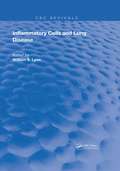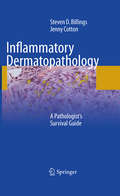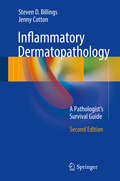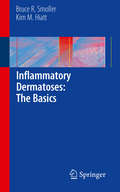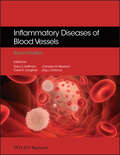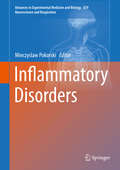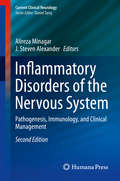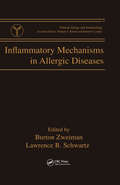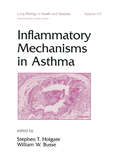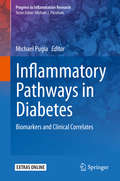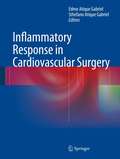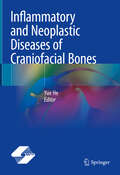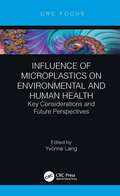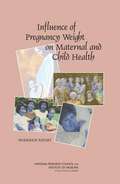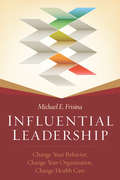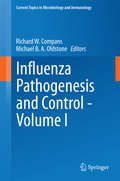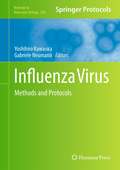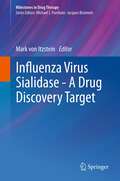- Table View
- List View
Inflammatory Breast Cancer
by Jaime G. de la Garza-Salazar Claudia Arce-Salinas Abelardo Meneses-GarciaThis book aims to bring together clinical information on the biology, diagnosis, therapy and management of patients with inflammatory breast cancer. Authored by experts from the Instituto Nacional de Cancerologia in Mexico, this book will provide the reader with the state-of-the art treatment of this rare but pernicious disease.
Inflammatory Breast Cancer: An Update
by Tamara Fink Naoto T. UenoInflammatory breast cancer is the most deadly subtype of breast cancer because it can spread to other organs despite of multidisciplinary approach. However, the molecular characteristic of this aggressive disease is yet to be established. This book is the one of the few textbooks that summarizes the latest information dated to inflammatory breast cancer. The uniqueness of this book is that it has summarized the latest molecular and mechanistic findings, which may lead to novel diagnostic tool or therapeutic approach to fight this deadly disease.
Inflammatory Cells & Lung Disease (Routledge Revivals)
by William S. LynnFirst Published in 1983, this book offers a full, comprehensive guide into the relationship between inflammatory cells and our Lungs. Carefully compiled and filled with a vast repertoire of notes, pictures, and references this book serves as a useful reference for Students of Medicine, and other practitioners in their respective fields.
Inflammatory Cells and Mediators in Bronchial Asthma (Handbooks In Pharmacology And Toxicology Ser. #1)
by Devendra K. Agrawal Robert G. TownleyInflammatory Cells and Mediators in Bronchial Asthma provides reviews and summaries regarding state-of-the-art articles that examine the role of various inflammatory cells and their mediators in the pathogenesis of asthma. Topics include pharmacological and biochemical regulation of the airways; involvement of key inflammatory cells and the release and effect of their mediators in airway function; and the characteristics of receptors for leukotriene B4, C4, and D4, adenosine, platelet-activating factor, sensory and inflammatory peptides, and the effect of various anti-asthmatic drugs on airway inflammation. Physicians, allergists, immunologists, and pulmonary disease research scientists will find this book to be an invaluable reference resource.
Inflammatory Dermatopathology
by Jenny Cotton Steven D. BillingsInflammatory Dermatopathology: A Pathologist's Survival Guide provides expert guidance for the reader to develop a systematic approach to the diagnosis of inflammatory disorders of the skin. It covers the most common and clinically important inflammatory disorders of the skin through an image-rich easy to read format. Each section includes practical tips to help navigate the differential diagnosis. Microscopic features are listed as bullet points to enhance readability. Examples of diagnostic comments that practicing pathologists can utilize in their own reports are also provided. Demonstrating a global understanding of inflammatory dermatoses in a quick and efficient manner, Inflammatory Dermatopathology: A Pathologist's Survival Guide will both guide the reader in how to approach inflammatory dermatoses, as well as provide a tool that will help with the writing of surgical pathology reports.
Inflammatory Dermatopathology
by Jenny Cotton Steven D. BillingsThis fully updated and revised new edition will guide the reader to develop a systematic approach to the diagnosis of inflammatory disorders of the skin. It covers the most common and clinically important inflammatory disorders of the skin in a image-rich easy to read format. Each section includes a practical tips section to help navigate the differential diagnosis. Examples of diagnostic comments are provided that practicing pathologists can utilize in their own reports. Therefore, this book will not only guide the reader in how to approach inflammatory dermatoses, it will also help with writing the report. All chapters are revised and updated and include new images. The second edition of Inflammatory Dermatopathology will be of great value to surgical pathologists, pathology residents, dermatology residents, and dermatopathology fellows.
Inflammatory Dermatoses: The Basics
by Bruce R. Smoller Kim M. HiattInflammatory Dermatoses: The Basics will serve as an effective and efficient handbook for the student of dermatopathology, and as a practical bench reference for the practicing diagnostician who desires rapid access to criteria that are useful in differentiating histologically similar entities. The reader will be able to focus upon a single histologic observation, i.e., inflammatory conditions without epidermal changes, and use this as a starting point from which to build a differential diagnosis based upon pattern recognition. As each entity is addressed, there will be a concise discussion of the basic clinical findings and epidemiologic associations. This will be followed by a histologic description, highlighting areas that serve to discriminate between the entity under discussion and similar ones. Any immunologic studies that might augment the diagnostic sensitivity or specificity will be discussed. The chapters are thematically based and consist of essential bullet points arranged in organized outlines allowing for easy access and direct comparison between entities. The salient histologic features are depicted with abundant high quality, full-color photomicrographs placed immediately adjacent to the appropriate histologic bullet points. This volume will serve as an effective and efficient handbook for the student of dermatopathology, and as a practical bench reference for the practicing diagnostician who desires rapid access to criteria that are useful in differentiating histologically similar entities. The elaborate pictorial documentation will also enable the book to serve as an atlas of the commonest dermatologic disorders.
Inflammatory Diseases of Blood Vessels
by Carol A. Langford Jorg J. Goronzy Gary S. Hoffman Cornelia M. WeyandIn recent years, considerable progress has been made in understanding the vasculitic diseases, largely due to the introduction of effective treatments for diseases that were once uniformly fatal, the conduct of structured clinical studies, and advances in immunology and molecular biology. Despite these achievements, the vasculitic diseases continue to be associated with morbidity and mortality from chronic organ damage, relapses, and the side effects of treatment. Investigations into the mechanisms of vascular inflammation may lead to a better comprehension of the pathogenesis of vasculitic diseases and to treatment that is more effective and less toxic. These areas of promising research, together with current knowledge about the vasculitic diseases, are extensively examined in this new edition, which is designed to provide a comprehensive overview of the science and clinical consequences of vascular inflammation in health and disease.
Inflammatory Diseases of the Brain
by Stefan HähnelThis second, updated edition of Inflammatory Diseases of the Brain provides a comprehensive overview of the field from a neuroradiological point of view. In order to ensure a standardized approach throughout, each disease-oriented chapter is again subdivided into three principal sections: epidemiology, clinical presentation, and therapy; imaging; and differential diagnosis. A separate chapter addresses technical and methodological issues and imaging protocols. An important focus of the book is the current role of advanced MR imaging techniques, such as diffusion and perfusion MRI and MR spectroscopy, in the differentiation of inflammatory and other brain diseases. All of the authors are recognized experts, and the numerous high-quality and informative illustrations include some not contained in the first edition. This book will be of great value not only to neuroradiologists but also to neurologists, neuropediatricians, and general radiologists.
Inflammatory Disorders
by Mieczyslaw PokorskiThe mechanistic basis of chronic inflammation remains unclear. The research sheds new light on the immune cells expressing the activation markers HLA-DR and regulatory T cells (Tregs) and the cells expressing Siglec receptors as being key players in the immune system responsiveness to antigens and thus in lung tissue damage of chronic inflammation. The results help understand the mechanisms of action of common drugs used in COPD, such as formoterol, tiotropium, or corticosteroids, and point to novel drug targets. The chapters also deal with brain damaging effects, by far unrecognized, of inhaled corticosteroid therapy, a time-proven management of chronic inflammatory airway conditions; asthma being a case in point. Novel methods, likely less producing side effects, of macrolide antibiotics administration by inhalation are discussed, emphasizing not only bacteriostatic but also anti-inflammatory action.
Inflammatory Disorders of the Nervous System
by Alireza Minagar J. Steven AlexanderA cutting-edge review of the fundamental biological principles underlying the more common inflammatory disorders of the nervous system. The authors provide extensive updates on the latest findings concerning the mechanisms of inflammation and introduce such new concepts and methodologies as "endothelial and leukocyte microparticles" and "gene microarray technology" to help explain important links between the central nervous system (CNS) and general inflammatory processes. Among the diseases examined from an inflammatory perspective are multiple sclerosis, acute disseminated encephalomyelitis, optic neuritis, transverse myelitis, CNS vasculitis, neuropsychiatric systemic lupus erythematosis, Alzheimer's disease, and Parkinson's disease. The role of the immune system in neuroinflammation is also explored in such disorders as neurosarcoidois, HIV-Associated dementia, and HTLV-associated neurological disorders.
Inflammatory Mechanisms in Allergic Diseases (Clinical Allergy And Immunology Ser. #Vol. 16)
by Burton Zweiman Lawrence B. SchwartzContains patterns of allergic reactivity for disorders such as asthma, atopic dermatitis, urticaria, and anaphylaxis. Written by leading experts in the field, Inflammatory Mechanisms in Allergic Diseases covers non-anaphylactic drug disorders; synthesis and formation of IgE antibodies; new treatments using allergenic peptides, immunostimulatory oligonucleotides, and pharmacogenomics;recent advances targeting effector mechanisms; hypersensitivity reactions to drugs and more! With over 3100 references, tables, drawings, and micrographs, Inflammatory Mechanisms in Allergic Diseases is an essential reference for allergists, pulmonologists, immunologists, dermatologists, ophthalmologists, otolaryngologists, internists, pediatricians, family practitioners, and medical students in these disciplines.
Inflammatory Mechanisms in Asthma
by Stephen T. Holgate William W. BusseThis timely volume brings together the latest basic and clinical insights on the cellular and mediator mechanisms involved in the induction and persistence of airway dysfunction of asthma by over 90 experts in the field-paving the way for developing novel and more effective antiinflammatory therapeutic agents and strategies. Furnishing a comprehensive and up-to-date view of the expanding and interrelated components underlying asthma pathogenesis, Inflammatory Mechanisms in Asthma describes how evidence on airway inflammation is obtained with invasive and noninvasive procedures, such as bronchoalveolar lavage and sputum analysis reviews the complex interactions of inflammatory cells that contribute to chronic inflammation and bronchial hyperreactivity, including eosinophils, basophils, neutrophils, fibroblasts, epithelial cells, and macrophages considers mast cells, cytokines, neural factors, leukotrienes, kinins, and other mediators that regulate the development, establishment, or resolution of asthma exacerbations presents new information suggesting that airway changes in asthma can lead to remodeling or airway fibrosis and more! Enhanced with over 4700 references, tables, drawings, and photographs, this compelling investigation into the pathophysiology of asthma is an indispensable resource for pulmonologists, physiologists, immunologists, allergists, epidemiologists, biochemists, molecular biologists, and graduate and medical school students in these disciplines.
Inflammatory Mechanisms in Mediating Hearing Loss
by Vickram Ramkumar Leonard P. RybakCommon forms of preventable hearing loss are drug and noise-induced hearing loss which are believed to be produced by a similar mechanism. The generation of reactive oxygen species appears to be a common mechanism mediating hearing loss produced by these different sources. As such, a number of laboratories have focused their research towards identifying the sources of ROS production in the cochlea following administration of chemotherapeutic agents or noise exposure. This led to the identification of ROS generating enzymes, such as xanthine oxidases, nitric oxide synthase, and NADPH oxidases which are activated and/or induced during the development of hearing loss. A consequence of these findings was the implementation of antioxidants in preclinical studies for the treatment of hearing loss. These antioxidants have provided different levels of protection in animal and human studies, but none of these have been approved by the US Food and Drug Administration for the treatment of hearing loss. More recently, it was shown that noise-induced hearing loss was associated with recruitment of inflammatory cells and mediators in the cochlea. This finding would suggest that noise could produce injury to the cochlea which stimulates local and/or circulating inflammatory cells. A similar finding was observed in the cochlea following administration of the anticancer drug, cisplatin. In addition, our laboratory and others have provided a plausible mechanism by which noise or chemotherapeutic agents could stimulate the inflammatory response. Surprisingly, this mechanism involves ROS activation of transcription factors linked to inflammatory processes in the cochlea. These studies have led to the use of anti-inflammatory agents for the treatment of hearing loss. Preliminary studies targeting inflammatory cytokines appear especially promising in preclinical studies. A primary goal of this project is to describe our current understanding of the oxidant hypothesis of noise and drug-induced hearing loss and show how this relates to cochlear inflammation. Several different aspects of the cochlear inflammatory process will be discussed in detail, ranging from the sources of inflammatory cells, chemokines, inflammatory cytokines, and cochlea resident immune cells. Molecular pathways leading to activation of the local inflammatory process will be highlighted and treatment options will be discussed. The relevance of certain clinically used anti-inflammatory interventions, such as trans-typmanic steroids will also be discussed. Furthermore, we will examine recent patents focusing on the use of anti-inflammatory agents for the treatment of drug and noise-induced hearing loss.
Inflammatory Pathways in Diabetes
by Michael PugiaThis book discusses recent advances in new anti- and pro-inflammatory pathways in diabetic disease, and identifies new diagnostic immunological methods that offer potential companion diagnostics for diabetic diseases. New methods in proteomics, mass spectroscopy, immunological assay design, measurement of cellular signal transduction and protease inhibition are used to clarify new biochemical pathways. Biomarker validation in animal models and correlations in humans for diagnostic clinical trials shed new light on the impact of diabetic diseases. The book reviews current understanding of inflammatory pathways in the pathophysiology of insulin resistance, metabolic syndrome, nephritis and other diabetic inflammatory conditions, and is the first to describe the impact of novel adipokines, protease inhibitors and complement markers. By presenting new methodologies for biomarker discovery, it provides a valuable resource for researchers studying clinical diagnosis, drug development, bio-analytical chemistry, proteomics and biochemistry. It is also useful for those conducting clinical and biological studies for targeted drug development. The methodologies and approaches can be applied to other markers, and the information will be helpful in the preparation of research grant applications.
Inflammatory Response in Cardiovascular Surgery
by Edmo Atique Gabriel Sthefano Atique GabrielIn recent years, The impact of the inflammatory response in cardiovascular surgery has been a focus of much attention within the field of cardiac surgery. Despite that, scientific research on the topic is still lacking in the health science literature. To develop the bank of information available to all involved in the field, the Editors of this book have assembled a group of leading experts to investigate the most current and exciting topics related to inflammation and cardiovascular surgery. As such Inflammatory Response in Cardiovascular Surgery is vital reading for all involved in the management of cardiovascular surgical patients, such as cardiovascular and transplant surgeons, anesthesiologists, intensive care physicians, cardiovascular and vascular fellows, and researchers.
Inflammatory and Infectious Ocular Disorders (Retina Atlas)
by Hyeong Gon YuThis atlas covers most ocular inflammatory and infectious diseases of importance with clinical significance. It includes chapters on non-infectious diseases and chapters on infectious diseases. For each chapter, essential information regarding the clinical features, diagnosis, and management is described in the text based on the up-to-date knowledge, and more than 240 carefully selected photographs are provided. World-famous experts in this field have included as many as valuable photographs of patients as possible. New imaging tests of ultra-wide field retinal images and high-resolution optical coherence tomography are included in addition to conventional fundus photos and fluorescein angiographs. Especially, chapters on infectious diseases provide invaluable photos of rare but clinically important diseases. Designed to assist in the diagnosis and treatment of ocular inflammation and infection, this book is meant for the retina specialist, researchers of ocular inflammation, general ophthalmologist, resident and retina fellow. Inflammatory and Infectious Ocular Disorders atlas is one of the nine volumes of the series Retina Atlas. This series provides global perspective on vitreoretinal diseases, covering imaging basics, retinal vascular disease, macular disorders, ocular inflammatory and infectious disorders, retinal degeneration, surgical retina, ocular oncology, pediatric retina and trauma. This comprehensive atlas is spread over 9 volumes and about 100 chapters, covering validated and comprehensive information on retinal disorders.
Inflammatory and Neoplastic Diseases of Craniofacial Bones
by Yue HeThis book covers the full scope of fundamental oral and maxillofacial surgery, while supporting readers to focus on the essential information and disorders which are the most common, or have significant implications for modern clinical practice. It presents an overview of the most common clinical presentations, physical examination findings, diagnostic tools, complications, treatments, and discussions of differential diagnosis and related issues. Detailed illustrations including clinical photographs, radiological images and pathological slides provide a visual guide to conditions, techniques, diagnoses and key concepts. The most current clinical information also cover the minor and major complications which may occur in all facets of oral maxillofacial surgery. Readers can focus on the prompt recognition of each diagnosis, and consider differential diagnosis as well as precise management strategies in preventing complication and relapse. Case-based approach discussion can actively engage and raise the reader interest and retention of the information. Overall, the book provides a uniquely contemporary approach, reflecting the exciting developments of technique and instrumentation within this surgical field, built on technical innovation and state-of-art clinical practice. It is a readable resource, identifying commonalities and shedding light on controversies through reasoned discussion and balanced presentation of the evidence.
Influence of Microplastics on Environmental and Human Health: Key Considerations and Future Perspectives
by Yvonne LangMicroplastics have received increased attention in the research world over the last ten years. A number of significant publications by the World Health Organisation, European Union, SAPEA, and GESAMP have highlighted this growing environmental and health emergency. This book provides an accessible introduction to the microplastic problem and details its potential impact both on nature and human health. Filled with the latest developments in the field, it attempts to address the gaps in our knowledge of microplastics and will also propose additional areas of research and impact to be considered to resolve this crisis. It will be of interest to researchers and academics working in the areas of microplastic pollution, microplastic detection, and the impact of microplastics on environmental and human health. It will also be of use to undergraduate students of environmental programmes, analytical programmes, and public health programmes. Key Features: Chapters describe the impact of our reliance on plastics in certain sectors and how they relate to microplastic pollution Investigates emerging solutions to the microplastic pollution Presents a multi-disciplinary perspective, covering topics such as analytical techniques, quantitative techniques, environmental monitoring, and human health monitoring
Influence of Pregnancy Weight on Maternal and Child Health: WORKSHOP REPORT
by National Research Council Institute of Medicine of the National AcademiesThe National Academies Press (NAP)--publisher for the National Academies--publishes more than 200 books a year offering the most authoritative views, definitive information, and groundbreaking recommendations on a wide range of topics in science, engineering, and health. Our books are unique in that they are authored by the nation's leading experts in every scientific field.
Influential Leadership: Change Your Behavior, Change Your Organization, Change Health Care (ACHE Management)
by Michael FrisinaLeaders make things happen. Influential leaders go a step further by making a positive difference in organizations and in the lives of people who both serve and are served by the organization. Influential leaders perform at a higher level, are more productive, and achieve greater results than other leaders with similar circumstances and resources. Influential Leadership reveals: How good people skills—trust and accountability, not processes—can strengthen the organization’s pursuit of performance excellence How leaders and staff will change their behavior when they understand how it affects the outcome of their work, the lives of those around them, and the organization’s performance How self-aware, influential leaders are in a better position to collaborate and connect with others and to lead the organization to success “Dr. Frisina’s words get right to the heart of what sets apart truly great leaders, and are a road map for the journey.” —Lynn B. Wythe, RN, MSN, CNOR, director of nursing, Palmetto Health Baptist, Columbia, South Carolina “The author exhibits a passion for leadership excellence. . . . This book is a must for everyone entering into a leadership position, from the front-line manager to the CEO.” —Philip K. Beauchamp, LFACHE, president and CEO (ret.), Morton Plant Mease Healthcare, Inc., Clearwater, Florida “Chock full of examples and self-assessment tools. . . . The powerful takeaways from each section form an agenda for leading transformational change.” —Laura Avakian, leadership consultant, author, and past president of the American Society for Healthcare Human Resources Administration “Dr. Frisina leverages a lifetime of observations and hard-earned wisdom to give us a handful of guiding principles to make us all better leaders in our professional and personal lives.” —William R. Berry, MD, MPH, FACS, research associate, Department of Health Policy and Management, Harvard School of Public Health
Influenza Pathogenesis and Control - Volume II
by Michael B. A. Oldstone Richard W. CompansThis two-volume work covers the molecular and cell biology, genetics and evolution of influenza viruses, the pathogenesis of infection, resultant host innate and adaptive immune response, prevention of infection through vaccination and approaches to the therapeutic control of infection. . Experts at the forefront of these areas provide critical assessments with regard to influenza virology, immunology, cell and molecular biology, and pathogenesis. Volume I provides overviews of the latest findings on molecular determinants of viral pathogenicity, virus entry and cell tropism, pandemic risk assessment, transmission and pathogenesis in animal species, viral evolution, ecology and antigenic variation, while Volume II focuses on the role of innate and adaptive immunity in pathogenesis, development of vaccines and antivirals.
Influenza Vaccines for the Future
by Rino Rappuoli Giuseppe Del GiudiceThe emergence of H5N1 avian influenza in 1997 and of the influenza A H1N1 of swine origin in 2009 calls for new, rapid and sustainable solutions for both seasonal and pandemic influenza viruses. During the last ten years, science and technology have made enormous progress, and we are now able to monitor in real time the genetics of viruses while they spread globally, to make more powerful vaccines using novel adjuvants, and to generate viruses in the laboratory using reverse genetics. This volume not only provides state-of-the-art information on the biology of influenza viruses and on influenza vaccines, but is also designed to be a resource to face the present H1N1 pandemic and to plan for long-term global and sustainable solutions.
Influenza Virus
by Gabriele Neumann Yoshihiro KawaokaReports of influenza-like illnesses date back to the Middle Ages, and outbreaks of influenza likely afflicted humans long before that. Over the last half century, influenza virus research has led to the development of two classes of antivirals - ion channel and neuraminidase inhibitors. Recently, a method of the artificial generation of an influenza virus was established. This system has been instrumental in the development of novel influenza vaccines and in the understanding of viral pathogenicity and the functions of viral proteins. Influenza Virus: Methods and Protocols summarizes the current techniques that have made this progress possible, ranging from protocols for virus isolation, growth, and subtyping to procedures for the efficient generation of any influenza virus. Written in the successful Methods in Molecular BiologyTM series format, chapters include introductions to their respective topics, lists of the necessary materials and reagents, step-by-step, readily reproducible protocols, and notes on troubleshooting and avoiding known pitfalls. Authoritative and easily accessible, Influenza Virus: Methods and Protocols seeks to serve both professionals and novices with the techniques used in numerous laboratories around the world that are, thus, the building blocks that underpin almost all influenza virus research.
Influenza Virus Sialidase - A Drug Discovery Target
by Mark Von ItzsteinInfluenza continues to be an ongoing problem despite the existence of vaccines and drugs. Disease outbreaks can occur relatively quickly as witnessed with the recent emergence of the influenza virus A/H1N1 pandemic. The development of new anti-influenza drugs is thus a major challenge. This volume describes all aspects of the virus structure and function relevant to infection. The focus is on drug discovery of inhibitors to the enzyme sialidase, which plays a key role in the infectious lifecycle of the virus. Following an overview of the influenza virus, the haemagglutinin, the interactions with the cell receptors and the enzymology of virus sialidase, recent results in drug design are presented. These include a full coverage of the design, synthesis and evaluation of carbohydrate as well as non-carbohydrate influenza virus sialidase inhibitors. Further reviews of the clinical experience with influenza virus sialidase inhibitors and of the development of resistance to these inhibitor drugs complement the topic.


